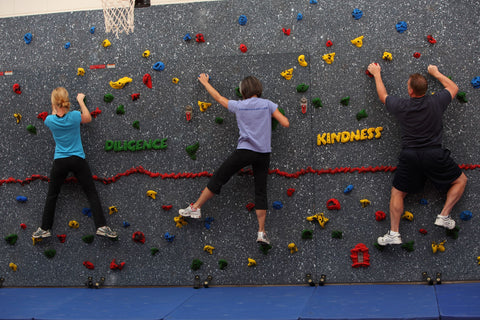
Ten Ways to Refresh Your Traverse Wall®
Keep your climbing wall exciting and engaging to climbers over time by periodically refreshing how you use it or changing its components. These refreshers help you get the most out of your Traverse Wall® and maximize its benefits for your climbers. Here are some ideas for you to consider:
1. Rotate or Reset your Hand Holds.
Our hand holds are versatile and designed to be used from all sides. Some positions are easier than others to grasp. Using the installation instructions and Allen wrench that came with your climbing wall, one by one, loosen some hand holds and rotate them 45 – 180 degrees. Play around with the options you get when you rotate the holds and once you choose a new position, tighten the holds. This will create an entirely new climbing experience and takes a lot less time than removing all holds and setting all new routes. If you have the time, resetting your climbing wall is another great way to give things a refresh.
2. Try New Activities!
Providing new climbing experience and challenges is an excellent way to make the climbing experience feel brand new. Check out our 30 in 30 Webinar that shares 30 Traverse Wall® activities in under 30 minutes. It’ll give you many new ideas to try with your climbers.
3. How Low Can You Go?
Climbers tend to want to climb as high as possible, even on a Traverse Wall®. Encourage your climbers to climb low, as low as they can go, while still remaining on the wall. This will challenge them in new ways, even if the activity is a familiar one.

4. Add Accessories.
The Climbing Wall Challenge Course and Versa® Challenge Course bring some new physical challenges to the climbing experience by adding obstacles that climbers have to navigate over, under around or through. Bring some cognitive challenges and cross-curricular learning to the climbing wall with Discovery® Plates. These magnetic, dry-erase plates fit between the climbing wall and hand holds and enable climbers to write and place magnets for a myriad of learning opportunities or games.
5. Use the Climbing Wall in Sections.
Instead of using your entire climbing wall for an activity, divide it into sections and have partners or small groups use each section simultaneously. You can mark the sections with tape on the climbing wall or with soft cones on the mats. One 4’x8’ section is great for partner activities like Twister®. Sections of two or three panels can be used with small groups for activities such as Add On.

6. Add an Overhang.
Increase the challenge of your climbing wall with an Overhang. It can be added adjacent to your existing wall, at either or both ends. It’s built at a 14° angle and really helps to develop new climbing skills.
7. Change Sides or Start in the Middle of the Climbing Wall.
Sometimes start activities from the left side, with climbers climbing to the right. Other times start activities from the right side, with climbers moving to the left. This challenges participants to lead with different sides of the body. You can also start activities in the middle of your climbing wall and have climbers move to each end.
8. Add Volumes.
Adding Volumes to your climbing wall instantly takes it to the next level and challenges climbers to use the holds on the Volumes which requires different hand maneuvers and increased grip strength. If adding some increased challenges to your climbing wall are a goal, Volumes are a great way to go.

9. Invite Guests to Climb!
It’s always fun for climbers to see the adults in their lives experiencing the climbing wall. Invite parents, teachers or administrators to climb! Your climbers can even be in charge of explaining safety rules and the activity of the day to their guest climbers.
10. Reflect and Share.
At the end of a climbing session, save a few minutes to discuss the experience. Ask one question and allow a few minutes for climbers to reflect, share and discuss. Here are some possible questions:
- What was your favorite part about climbing today?
- What was the hardest part about the climbing activity?
- Describe a feeling you had on the climbing wall today. How did it help or hinder your climbing?
- If you had a chance to do the activity again, what would you do differently?
- What part did teamwork play in climbing today?

Leave a comment